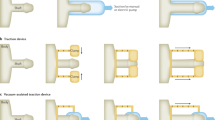Summary
This review assesses the continuing role of noninvasive vacuum therapy as treatment for erectile dysfunction and discusses the action of negative pressure in producing assisted erection. Though recent research in this area has centered on the development of pharmaceutical therapies, vacuum-therapy programs appear to be a consistent long-term option for patients experiencing either chronic or occasional impotence of any etiology. Very little testing is required before the initiation of vacuum treatment, and the overall clinical success rate is approximately 90%. Significant success has been reported in more difficult patient populations, including those with veno-occlusive disorders and explanted penile prostheses. Vacuum therapy may also be used in conjunction with other therapies to enhance results. Contraindications to the use of vacuum therapy are few and primarily include patients with unexplained intermittent priapism and bleeding disorders. Side effects such as occasional numbness, pain, penile bruising, or petechiae have a low incidence. A recently reported survey of 5, 847 vacuum users showed that 83.5% of patients continue to use the device for intercourse as desired. Patients should receive individual instruction in the use of these devices and should expect a learning or practice period to achieve optimal results. As newer treatments for erectile dysfunction gain increasing attention, it should be kept in mind that nearly every patient showing impotence of any degree or duration as well as patients who have failed other therapeutic choices are candidates for vacuum therapy.
Similar content being viewed by others
References
Althof SE, Turner LA, Levine SB, Bodner DR, Kursh ED, Resnick MI (1992) Through the eyes of women: the sexual and psychological responses of women to their partner's treatment with self-injection or external vacuum therapy. J Urol 147: 1024–1027
Blackard CE, Borkon WD, Lima JS, Nelson J (1993) Use of vacuum tumescence device for impotence secondary to venous leakage. Urology 41: 225–230
Chen J, Godschalk MF, Katz PG, Mulligan T (1995) Combining intracavernous injection and external vacuum as treatment for erectile dysfunction. J Urol 153: 1482
Cookson MS, Nadig PW (1993) Long-term results with vacuum constriction device. J Urol 149: 290–294
Gilbert HW, Gingell JC (1992) Vacuum constriction devices: second-line conservative treatment for impotence. Br J Urol 70: 81–83
Gould JE, Switters DM, Broderick GA, deVere White RW (1992) External vacuum devices: a clinical comparison with pharmacologic erections. World J Urol 10: 68–70
Kim JH, Carson CC (1993) Development of Peyronie's disease with the use of a vacuum constriction device. J Urol 149: 1314–1315
Korenman SG, Viosca SSP (1992) Use of vacuum tumescence device in the management of impotence in men with a history of penile implant or severe pelvic disease. JAGS 40: 61–64
Lewis JH (1993) Nursing management for patients using external vacuum devices: a unique opportunity. Urol Nurs 13: 80–85
Limoge J, Olin E, Kreder K, Donatucci C (1994) External vacuum therapy versus intracavernous autoinjection of vasoactive drugs in anticoagulated patients with erectile dysfunction: a study of safety. J Urol 151: 478A
Marmar JL, DeBenedictis TJ, Praiss DE (1988) The use of a vacuum constrictor device to augment a partial erection following an intracavernous injection. J Urol 140: 975–979
Meinhardt W, Kropman RF, Lycklama a Nijeholt AAB, Zwartendijk J (1990) Skin necrosis caused by use of negative pressure device for erectile impotence. J Urol 144: 983
Meinhardt W, Lycklama a Nijeholt AAB, Kropman RF, Zwartendijk J (1993) The negative pressure device for erectile disorders: when does it fail? J Urol 149: 1285–1287
Moul MW, McLeod DG (1989) Negative pressure devices in the explanted penile prosthesis population. J Urol 142: 729–731
Nadig PW (1989) Six years experience with the vacuum constriction device. Int J Impotence Res 1: 55–58
Nadig PW, Ware JC, Blumoff R (1986) Non-invasive device to produce and maintain an erection-like state. Urology 27: 126–131
Salvatore FT, Sharman GM, Helstrom WJ (1991) Vacuum constriction devices and the clinical urologist: an informed selection. Urology 38: 323–327
Sidi AA, Becher EF, Zhang G, Lewis JH (1990) Patient acceptance of and satisfaction with an external negative pressure device for impotence. J Urol 144: 1154–1156
Turner LA, Althof SE, Levine SB, Bodner DR, Kursh ED, Resnick MI (1991) External vacuum devices in the treatment of erectile dysfunction: a one-year study of sexual and psychosocial impact. J Sex Marital Ther 17: 81–93
Turner LA, Althof SE, Levine SB, Bodner DR, Kursh ED, Resnick MI (1992) Twelve-month comparison of two treatments for erectile dysfunction: self-injection versus external vacuum devices. Urology 39: 139–144
Villeneuve R, Carcas J, Carmel M (1991) Assisted erection follow up with couples. J Sex Marital Ther 17: 94–100
Witherington R (1989) Vacuum constriction device for management of erectile dysfunction. J Urol 141: 320–322
Witherington R (1995) Long-term follow up (2–21 years) of users of external vacuum devices for treatment of impotence (abstract). Proceedings AUA New York section meeting. October 9–13, Istanbul, Turkey
Author information
Authors and Affiliations
Rights and permissions
About this article
Cite this article
Lewis, R.W., Witherington, R. External vacuum therapy for erectile dysfunction: use and results. World J Urol 15, 78–82 (1997). https://doi.org/10.1007/BF01275162
Issue Date:
DOI: https://doi.org/10.1007/BF01275162




